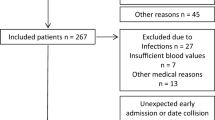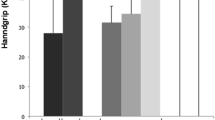Abstract
Limited knowledge exists on cardiorespiratory fitness (CR fitness) in adults having a renal transplant (Rtx) during childhood. Our aim was to assess CR fitness (V02peak) with a maximal treadmill test in former Rtx children reaching adulthood (ped-tx, n = 31), compared to patients Rtx as adults (adult-tx, n = 17) and healthy controls (HC, n = 36). Median age was 26.9 (19–41), 28.6 (23.5–34) and 33.5 (20–42) years, respectively. Median time since first Rtx was 18.1 (7–29) and 3.7 (1.2–12.6) years. Body composition was measured by dual-energy X-ray absorptiometry (DXA). V02peak was median 37.9 (12.5–56.3), 40.8 (26.5–57.5), and 44.4 (29.5–65.6) ml kg –1min –1 in the ped-tx, adult-tx, and HC, respectively. Ped-tx had significantly lower V02peak compared to HC (p = 0.01). Adult-tx had higher exercise capacity (test duration) compared to ped-tx (median 10.5 (7.5–16) and 9 (6–14) min, respectively (p = 0.016). In multiple linear regression analysis, test duration, fat-free mass (FFM, kg) and Hgb (g/dl) were significant predictors of V02peak explaining 86% of its variance. There was no significant difference between ped-tx and adult-tx in V02peak. CR fitness depicts long-term health outcome in Rtx patients both in regard to physical functioning and is a plausible indirect marker of CV health.



Similar content being viewed by others
References
Rees L, Shroff R, Hutchinson C, Fernando ON, Trompeter RS (2007) Long-term outcome of paediatric renal transplantation: follow-up of 300 children from 1973 to 2000. Nephron Clin Pract 105:c68–c76
Wilson AC, Mitsnefes MM (2009) Cardiovascular disease in CKD in children: update on risk factors, risk assessment, and management. Am J Kidney Dis 54:345–360
Rees L (2009) Long-term outcome after renal transplantation in childhood. Pediatr Nephrol 24:475–484
Becker-Cohen R, Nir A, Rinat C, Feinstein S, Algur N, Farber B, Frishberg Y (2006) Risk factors for cardiovascular disease in children and young adults after renal transplantation. Clin J Am Soc Nephrol 1:1284–1292
Koshy SM, Guttmann A, Hebert D, Parkes RK, Logan AG (2009) Incidence and risk factors for cardiovascular events and death in pediatric renal transplant patients: a single center long-term outcome study. Pediatr Transplant 13:1027–1033
Groothoff JW, Lilien MR, van de Kar NC, Wolff ED, Davin JC (2005) Cardiovascular disease as a late complication of end-stage renal disease in children. Pediatr Nephrol 20:374–379
Ekelund U, Anderssen SA, Froberg K, Sardinha LB, Andersen LB, Brage S (2007) Independent associations of physical activity and cardiorespiratory fitness with metabolic risk factors in children: the European Youth Heart Study. Diabetologia 50:1832–1840
Anderssen SA, Cooper AR, Riddoch C, Sardinha LB, Harro M, Brage S, Andersen LB (2007) Low cardiorespiratory fitness is a strong predictor for clustering of cardiovascular disease risk factors in children independent of country, age and sex. Eur J Cardiovasc Prev Rehabil 14:526–531
Lobelo F, Pate RR, Dowda M, Liese AD, Daniels SR (2010) Cardiorespiratory fitness and clustered cardiovascular disease risk in U.S. adolescents. J Adolesc Health 47:352–359
Erikssen G, Liestol K, Bjornholt J, Thaulow E, Sandvik L, Erikssen J (1998) Changes in physical fitness and changes in mortality. Lancet 352:759–762
Myers J, Prakash M, Froelicher V, Do D, Partington S, Atwood JE (2002) Exercise capacity and mortality among men referred for exercise testing. N Engl J Med 346:793–801
Carnethon MR, Gidding SS, Nehgme R, Sidney S, Jacobs DR Jr, Liu K (2003) Cardiorespiratory fitness in young adulthood and the development of cardiovascular disease risk factors. JAMA 290:3092–3100
Lee DC, Sui X, Ortega FB, Kim YS, Church TS, Winett RA, Ekelund U, Katzmarzyk PT, Blair SN (2010) Comparisons of leisure-time physical activity and cardiorespiratory fitness as predictors of all-cause mortality in men and women. Br J Sports Med. doi:https://doi.org/10.1136/bjsm.2009.066209
Bassett DR Jr, Howley ET (2000) Limiting factors for maximum oxygen uptake and determinants of endurance performance. Med Sci Sports Exerc 32:70–84
Krasnoff JB, Mathias R, Rosenthal P, Painter PL (2006) The comprehensive assessment of physical fitness in children following kidney and liver transplantation. Transplantation 82:211–217
Krull F, Schulze-Neick I, Hatopp A, Offner G, Brodehl J (1994) Exercise capacity and blood pressure response in children and adolescents after renal transplantation. Acta Paediatr 83:1296–1302
Painter P, Krasnoff J, Mathias R (2007) Exercise capacity and physical fitness in pediatric dialysis and kidney transplant patients. Pediatr Nephrol 22:1030–1039
Weaver DJ Jr, Kimball TR, Knilans T, Mays W, Knecht SK, Gerdes YM, Witt S, Glascock BJ, Kartal J, Khoury P, Mitsnefes MM (2008) Decreased maximal aerobic capacity in pediatric chronic kidney disease. J Am Soc Nephrol 19:624–630
Tangeraas T, Midtvedt K, Fredriksen PM, Cvancarova M, Morkrid L, Bjerre A (2010) Cardiorespiratory fitness is a marker of cardiovascular health in renal transplanted children. Pediatr Nephrol 25:2343–2350
Kempeneers G, Noakes TD, van Zyl-Smit R, Myburgh KH, Lambert M, Adams B, Wiggins T (1990) Skeletal muscle limits the exercise tolerance of renal transplant recipients: effects of a graded exercise training program. Am J Kidney Dis 16:57–65
Kim GB, Kwon BS, Kang HG, Ha JW, Ha IS, Noh CI, Choi JY, Kim SJ, Yun YS, Bae EJ (2009) Cardiac dysfunction after renal transplantation; incomplete resolution in pediatric population. Transplantation 87:1737–1743
Mitsnefes MM, Kimball TR, Border WL, Witt SA, Glascock BJ, Khoury PR, Daniels SR (2004) Abnormal cardiac function in children after renal transplantation. Am J Kidney Dis 43:721–726
Weiss R, Dziura J, Burgert TS, Tamborlane WV, Taksali SE, Yeckel CW, Allen K, Lopes M, Savoye M, Morrison J, Sherwin RS, Caprio S (2004) Obesity and the metabolic syndrome in children and adolescents. N Engl J Med 350:2362–2374
Fredriksen PM, Ingjer F, Nystad W, Thaulow E (1998) Aerobic endurance testing of children and adolescents–a comparison of two treadmill-protocols. Scand J Med Sci Sports 8:203–207
Instebo A, Norgard G, Helgheim V, Roksund OD, Segadal L, Greve G (2004) Exercise capacity in young adults with hypertension and systolic blood pressure difference between right arm and leg after repair of coarctation of the aorta. Eur J Appl Physiol 93:116–123
Cumming GR, Everatt D, Hastman L (1978) Bruce treadmill test in children: normal values in a clinic population. Am J Cardiol 41:69–75
Borg G (1970) Perceived exertion as an indicator of somatic stress. Scand J Rehabil Med 2:92–98
Haskell WL, Lee IM, Pate RR, Powell KE, Blair SN, Franklin BA, Macera CA, Heath GW, Thompson PD, Bauman A (2007) Physical activity and public health: updated recommendation for adults from the American College of Sports Medicine and the American Heart Association. Circulation 116:1081–1093
Craig CL, Marshall AL, Sjostrom M, Bauman AE, Booth ML, Ainsworth BE, Pratt M, Ekelund U, Yngve A, Sallis JF, Oja P (2003) International physical activity questionnaire: 12-country reliability and validity. Med Sci Sports Exerc 35:1381–1395
Kurtze N, Rangul V, Hustvedt BE (2008) Reliability and validity of the international physical activity questionnaire in the Nord-Trondelag health study (HUNT) population of men. BMC Med Res Methodol 8:63
Kelly TL, Wilson KE, Heymsfield SB (2009) Dual energy X-Ray absorptiometry body composition reference values from NHANES. PLoS ONE 4:e7038
Levey AS, Coresh J, Greene T, Marsh J, Stevens LA, Kusek JW, Van LF (2007) Expressing the Modification of Diet in Renal Disease Study equation for estimating glomerular filtration rate with standardized serum creatinine values. Clin Chem 53:766–772
Maggio AB, Hofer MF, Martin XE, Marchand LM, Beghetti M, Farpour-Lambert NJ (2010) Reduced physical activity level and cardiorespiratory fitness in children with chronic diseases. Eur J Pediatr 169:1187–1193
Florin TA, Fryer GE, Miyoshi T, Weitzman M, Mertens AC, Hudson MM, Sklar CA, Emmons K, Hinkle A, Whitton J, Stovall M, Robison LL, Oeffinger KC (2007) Physical inactivity in adult survivors of childhood acute lymphoblastic leukemia: a report from the childhood cancer survivor study. Cancer Epidemiol Biomarkers Prev 16:1356–1363
Jarvela LS, Niinikoski H, Lahteenmaki PM, Heinonen OJ, Kapanen J, Arola M, Kemppainen J (2010) Physical activity and fitness in adolescent and young adult long-term survivors of childhood acute lymphoblastic leukaemia. J Cancer Surviv 4:339–345
Telama R, Yang X, Viikari J, Valimaki I, Wanne O, Raitakari O (2005) Physical activity from childhood to adulthood: a 21-year tracking study. Am J Prev Med 28:267–273
Anderssen SA, Hansen BH, Kolle E, Lohne-Seiler H, Edvardsen E, Holme I (2010) Fysisk form blant voksne og eldre i Norge. [Physical fitness in adults and the elderly in Norway]. Norwegian Directorate of Health. Ref Type: Report
Wasserman K (2005) Principles of exercise testing and interpretation, ed Fourth edition. Lippincott, Philadelphia
Painter PL, Topp KS, Krasnoff JB, Adey D, Strasner A, Tomlanovich S, Stock P (2003) Health-related fitness and quality of life following steroid withdrawal in renal transplant recipients. Kidney Int 63:2309–2316
Armstrong K, Rakhit D, Jeffriess L, Johnson D, Leano R, Prins J, Garske L, Marwick T, Isbel N (2006) Cardiorespiratory fitness is related to physical inactivity, metabolic risk factors, and atherosclerotic burden in glucose-intolerant renal transplant recipients. Clin J Am Soc Nephrol 1:1275–1283
Painter P (2009) Determinants of exercise capacity in CKD patients treated with hemodialysis. Adv Chronic Kidney Dis 16:437–448
Ekelund U, Franks PW, Wareham NJ, Aman J (2004) Oxygen uptakes adjusted for body composition in normal-weight and obese adolescents. Obes Res 12:513–520
Vanderburgh PM, Katch FI (1996) Ratio scaling of VO2max penalizes women with larger percent body fat, not lean body mass. Med Sci Sports Exerc 28:1204–1208
Toth MJ, Goran MI, Ades PA, Howard DB, Poehlman ET (1993) Examination of data normalization procedures for expressing peak VO2 data. J Appl Physiol 75:2288–2292
Goran M, Fields DA, Hunter GR, Herd SL, Weinsier RL (2000) Total body fat does not influence maximal aerobic capacity. Int J Obes Relat Metab Disord 24:841–848
Riou ME, Pigeon E, St-Onge J, Tremblay A, Marette A, Weisnagel SJ, Joanisse DR (2009) Predictors of cardiovascular fitness in sedentary men. Appl Physiol Nutr Metab 34:99–106
Jørgensen T, Andersen LB, Froberg J, Maeder U, Von Huth SL, Aadahl M (2009) Position statement: testing physical condition in a population- how good are the methods? Eur J Sport Sci 9:257–267
Warburton DE, Nicol CW, Bredin SS (2006) Health benefits of physical activity: the evidence. CMAJ 174:801–809
Macdonald JH, Kirkman D, Jibani M (2009) Kidney transplantation: a systematic review of interventional and observational studies of physical activity on intermediate outcomes. Adv Chronic Kidney Dis 16:482–500
Acknowledgments
The authors gratefully acknowledge participants for their valuable contributions to this study, and to Kari Gjersum and Mai-Britt Lynum for coordinating services. This study was supported by grants from the Foundation of Renée and Bredo Grimsgaard, Oslo, Norway.
Author information
Authors and Affiliations
Corresponding author
Rights and permissions
About this article
Cite this article
Tangeraas, T., Midtvedt, K., Cvancarova, M. et al. Cardiorespiratory fitness in young adults with a history of renal transplantation in childhood. Pediatr Nephrol 26, 2041–2049 (2011). https://doi.org/10.1007/s00467-011-1898-6
Received:
Revised:
Accepted:
Published:
Issue Date:
DOI: https://doi.org/10.1007/s00467-011-1898-6




